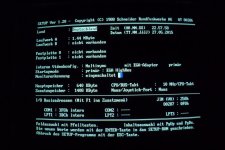I changed the Bios-Settings CPU/BUS from "10Mz/CPU-Takt", which means 10/10 to 10/5.
If I reboot the machine this particular Intro-Scene with the giant SpaceShip is absolute stutterfree !!

The reduction of the Bus-Speed causes 20% less GPU-Speed in the Landmark600 test (490->410),
but it causes some effects that the machine does not feel so fast as before with the 10/10 option.
But!, the 10/5 Option does not solve all down stuttering-problems.
First I must differentiate between "global stuttering" which most games have and "stuttering with flickering",
the stuttering with flickering (as you saw in the menace-intro) is in some games like "DDAVE", "CCAVES", "SAGENT".
Some of them have a "alternative scrolling" option which solves this problem, there is "only" global stuttering" left.
This scrolling issues are possible something for the next "nerdly-pleasures-article"

As "scali" already said, stutterfree scrolling was a domain of the old 8/16Bit Homecomputers, and the (early)
PC's have lot's of problems with that, that is a real mess.
Doc
****Edit****
Beside the first Shooter "MENACE" the follower "BLOOD-MONEY" does not get smooth scrolling.
The starfield in the Back of the planets look nice and is smooth, but the game stutters all the time.
it is a bit better by pressing "F4" during gameplay, but ist is far away from the amiga performance.
too bad that psygnosis did not include any other then pc-peepser. I alway thought about putting
audio in the old pc-ports of 16Bit Homecomputer-Stuff, but that is not realistic at any time in the future.

